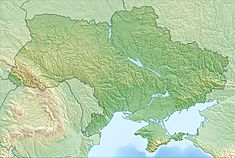Kakhovka Dam facts for kids
Quick facts for kids Kakhovka Dam |
|
|---|---|

The dam's spillways in use in 2013.
|
|
|
Location of Kakhovka Dam in Ukraine
|
|
| Official name | Kakhovska HPS |
| Location | Nova Kakhovka, Ukraine |
| Coordinates | 46°46′34″N 33°22′18″E / 46.77611°N 33.37167°E |
| Purpose | Power, irrigation, navigation |
| Status | Destroyed |
| Construction began | September 1950 |
| Opening date | 1956 |
| Demolition date | June 6, 2023 |
| Owner(s) | Energy Company of Ukraine |
| Dam and spillways | |
| Type of dam | Earth-fill embankment with gravity sections |
| Impounds | Dnieper River |
| Height | 30 m (98 ft) |
| Length | 3,273 m (10,738 ft) |
| Reservoir | |
| Creates | Kakhovka Reservoir |
| Total capacity | 18,180×106 m3 (14,738,766 acre⋅ft) |
| Surface area | 2,155 km2 (832 sq mi) |
| Power station | |
| Operator(s) | Ukrhydroenergo |
| Commission date | 1955–1956 |
| Turbines | 3 × 58.5, 3 × 60.5 MW propeller |
| Installed capacity | 357 MW |
| Annual generation | 1.4 TWh |
The Kakhovka Hydroelectric Station (Ukrainian: Кахо́вська ГЕС імені П. С. Непорожнього; commonly the Kakhovka Dam) was a run-of-river power plant from 1955 through early 2023 on the Dnieper River in Nova Kakhovka, Ukraine. Nova Kakhovka is a port city located on the reservoir's southern bank. The primary purposes of the dam were hydroelectric power generation, irrigation and navigation. It was the 6th and the last dam in the Dnieper reservoir cascade.
The deep water channel created by the downstream flow allowed shipping up and down river. The facility also included a winter garden. The P47 road and a railway crossed the Dnieper River on the dam.
The Kakhovka Hydroelectric Power Plant had 241 staff in October 2015. The director is Yaroslav Kobelya from September 2012. As of 2019, the dam was profitable bringing ₴6.1 million to local government budgets and ₴44.6 million to the national income.
During the Russian invasion of Ukraine, on the morning of 6 June 2023, a significant portion of the dam was destroyed, possibly by an explosion near the dam's center, releasing a large amount of water downstream.
Dam
The dam had an associated lock and a hydro power station with an installed capacity of 357 MW. Including the long embankments on both sides of the central section, the dam is 3.2 km (2.0 mi) wide on the side facing the reservoir. From north-west to south-east the central section consists of a barrage dam, the hydro power station, and the lock. Water from Kakhovka Reservoir supplies water for cooling the 5.7 GW Zaporizhzhia Nuclear Power Plant, and to irrigate areas of southern Ukraine and northern Crimea via the North Crimean Canal and Dnieper–Kryvyi Rih Canal. Construction on the dam began in September 1950. The last generator was commissioned in October 1956. It is operated by Ukrhydroenergo.
Starting in 2019 significant repairs and expansion were made to the facility.
This dam held 18 cubic kilometres of water, equivalent to the Great Salt Lake in Utah state.
Russian invasion of Ukraine
On 24 February 2022, the power plant was captured by Russian forces during the Russian invasion of Ukraine. During weeks of artillery attacks by Ukraine in August and September, Ukrainian and Russian officials reported that the facility's ability to transport vehicles had been degraded, but the dam itself retained structural integrity.
In mid-October 2022, news reports suggested that Russians may have been planning to blow up the dam to slow down the Ukrainian counter-offensive in the region.
On 11 November, a large explosion occurred on the dam, shown on CCTV footage. The road and rail sections were destroyed, but the dam itself remained mostly undamaged. Russian officials opened additional sluice gates, allowing water to rush out of the reservoir. At that time the Zaporizhzhia Regional Military Administration in a statement suggested that one of the purposes of draining the reservoir might have been to flood the area south of the dam, in order to keep Ukrainian Forces from crossing the Dnipro River. Officials stated that Ukrhydroenergo, Ukraine's hydro electric company, believed Russian forces "opened the station's locks fearing an advance of Ukrainian soldiers."
In early November 2022, the spillways at the dam had been opened, and the Kakhovka Reservoir dropped to its lowest level in three decades, putting irrigation and drinking water resources at risk, as well as the coolant systems for the Zaporizhzhia Nuclear Power Plant. Between 1 December 2022 and 6 February 2023, the water level dropped 2 meters.
In May 2023, water levels reached their highest recorded levels and water looked like it had started to flow over the top of the dam. This pushed water above normal levels and caused some nearby villages to flood. The rise appeared to be the result of Russia keeping too many gates closed.
Destruction of the dam
The hydroelectric power plant and road of the dam deteriorated a week before. On June 6, an explosion caused significant damage to the central section of the 3.2 km (2.0 mi) wide dam, resulting in uncontrolled water flow downstream. There was an occurrence of an "internal explosion of the structures" within the dam according to Ukrainian president Volodymyr Zelenskyy. Evacuations and rescue operations were commenced as a result.
BBC News acquired satellite imagery that revealed the deteriorating state of the dam since at least 1 June, or possibly even earlier. The imagery also highlighted that on 2 June, the road crossing the dam had experienced certain damages.



